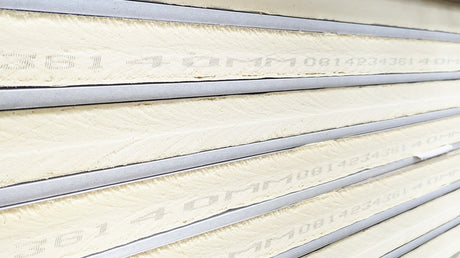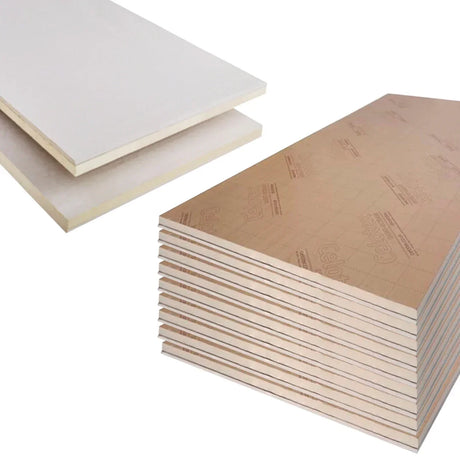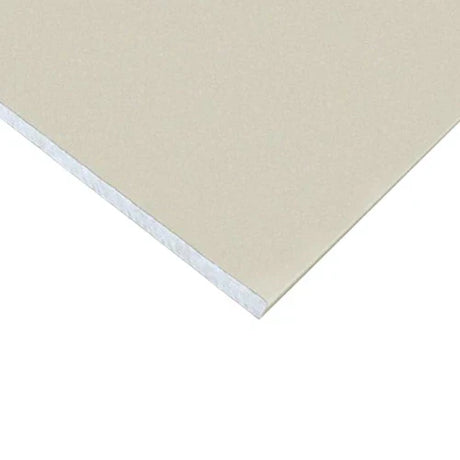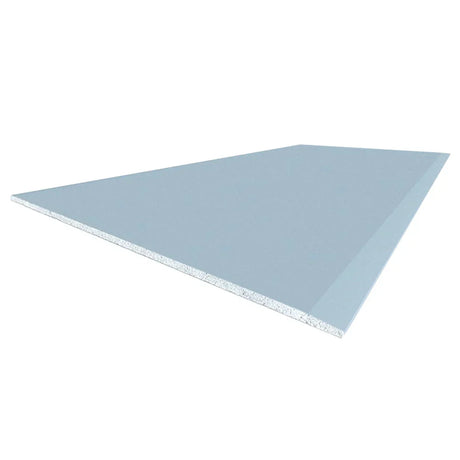When I first discovered water damage on my bathroom wall, I felt overwhelmed. The paint was peeling, there was an unsightly stain spreading across the plaster, and I worried about what lurked beneath the surface. Like many homeowners facing this situation, I wondered whether I needed to call in expensive professionals or if this was something I could tackle myself.
The answer, I discovered, lies in understanding the right materials and techniques. This guide will walk you through repairing damaged walls using moisture resistant plasterboard, sharing the lessons I learned along the way so you can approach your project with confidence.
Understanding the Problem: Why Moisture Damages Walls
Before diving into repairs, it's worth understanding what causes wall damage in moisture-prone areas. Bathrooms, kitchens, utility rooms, and any space exposed to steam or splashing water face constant challenges. Standard plasterboard simply isn't designed to cope with these conditions. Over time, moisture penetrates the surface, weakening the gypsum core and creating the perfect environment for mould growth.
The consequences extend beyond aesthetics. Damaged walls lose their structural integrity, insulation becomes compromised, and mould poses genuine health risks to your family. This is precisely why moisture resistant plasterboard exists—it's engineered specifically to withstand these challenging conditions.
What Makes Moisture Resistant Plasterboard Different?
When I first visited my local builders' merchant, I was surprised to learn about the sophisticated engineering behind what looks like a simple building board. Moisture resistant plasterboard, often identified by its distinctive green colour, features a specially treated gypsum core with added water-repellent additives. Leading British manufacturers like Knauf and British Gypsum have refined these formulations over decades.
The board's faces are covered with specially treated paper that resists water penetration, whilst the core itself contains silicone or similar hydrophobic agents that prevent moisture absorption. This doesn't mean the board is waterproof—nothing that breathes can be entirely waterproof—but it significantly outperforms standard plasterboard in damp conditions.
Assessing Your Wall Damage
Before purchasing materials, you need to understand the extent of your damage. I learned this lesson the hard way when I initially underestimated my repair area. Start by checking the affected area thoroughly. Press gently on the damaged section—if it feels soft or spongy, the damage extends deeper than the surface. Look for discolouration, which often spreads beyond the obvious problem area.
Use a moisture meter if possible. These inexpensive devices, available from most DIY stores, reveal hidden dampness that isn't visible to the eye. Mark the full extent of the damage with a pencil, adding an extra 100mm beyond the affected area. This ensures you're working with sound material around the edges of your repair.
Crucially, identify and resolve the source of moisture before proceeding. There's no point installing moisture resistant plasterboard if you haven't fixed the leaking pipe or improved ventilation that caused the original problem. I spent an afternoon tracking down a slow leak behind my bathroom basin—tedious work that proved absolutely essential.
Gathering Your Materials and Tools
Success in any DIY project starts with proper preparation. For wall repairs using moisture resistant plasterboard, you'll need specific materials and tools. From DIY Building Supplies or your local merchant, source your moisture resistant plasterboard in the appropriate thickness—typically 12.5mm for most domestic applications.
You'll also need joint tape, joint compound, screws designed for plasterboard (drywall screws with a fine thread work perfectly), and a suitable primer. For tools, gather a utility knife with fresh blades, a drywall saw or jigsaw, a drill with a screwdriver bit, a tape measure, a spirit level, sandpaper in various grades, and filling knives in different widths.
Don't forget safety equipment. Cutting plasterboard creates fine dust that you shouldn't breathe, so wear a dust mask. Safety glasses protect your eyes, whilst work gloves prevent cuts from sharp edges.
Removing the Damaged Section
With everything prepared, begin by removing the damaged plasterboard. This stage felt daunting initially, but following a systematic approach made it manageable. First, turn off electricity to any sockets or switches in the affected area—safety must come first.
Using your utility knife, score along your marked lines. For the first cut, I recommend going lightly to establish your path, then making deeper passes. The knife should cut through the paper facing easily. Once scored, you can use your drywall saw to cut through the gypsum core.
Work carefully around the perimeter of your marked area. Standard plasterboard is fixed to timber studs or battens behind, so you're cutting through the board whilst avoiding the structural elements. As you near the edges, you'll feel the resistance change when you encounter the supporting timber.
Remove the damaged section carefully. It often comes away in pieces—don't worry if it's not one clean sheet. What matters is removing all compromised material. Once removed, inspect the cavity behind. Check the timber framing for any dampness or damage. If present, allow it to dry completely before proceeding. In severe cases, you might need to treat or replace damaged timber.
Preparing for Installation
The cavity behind your removed plasterboard needs attention before installing the replacement. Clean away any debris, old adhesive, or loose material. This is your opportunity to check and improve insulation if needed. In external walls particularly, ensuring adequate insulation behind your moisture resistant plasterboard improves both energy efficiency and condensation control.
Measure your opening carefully. Moisture resistant plasterboard should fit snugly but not require forcing. I found it helpful to measure in multiple places, as older walls rarely have perfectly square openings. Cut your board slightly smaller than the opening—about 3mm clearance all round allows for easy fitting whilst remaining small enough to fill neatly.
Cutting moisture resistant plasterboard follows the same principles as standard board. Score the face paper deeply with your utility knife against a straight edge, snap the board along the score line, then cut through the paper on the reverse. Smooth any rough edges with your sandpaper.
Installing Your Moisture Resistant Plasterboard
Position your cut board in the opening before fixing to ensure it fits properly. When satisfied, begin fixing it to the supporting timber. I learned to start with one screw in the centre of each edge, which holds the board in position whilst you complete the fixing pattern.
Space screws approximately 200mm apart around the perimeter and across any intermediate supports. Drive screws until the head sits just below the surface—what plasterers call "dimpling"—but avoid breaking through the paper face. This dimple accommodates joint compound whilst the unbroken paper maintains board strength.
Work systematically around the board, ensuring it sits flat against the supports. If you encounter any resistance, don't force it—investigate and resolve the cause. The board should sit naturally in position.
Finishing the Repair
With your moisture resistant plasterboard fixed securely, finishing transforms your visible repair into an invisible one. Apply joint tape over all seams where your new board meets existing walls. This reinforcement prevents cracks developing along joints.
Cover the tape with your first coat of joint compound, using a filling knife to spread it smoothly. This initial coat needn't be perfect—it's providing a base for subsequent coats. Allow it to dry completely according to the manufacturer's instructions.
Apply a second coat, feathering the edges outward to blend with the surrounding wall. This coat requires more attention to create a smooth transition. Once dry, sand lightly with fine-grit paper, then apply a final thin coat if needed.
The dimples over screw heads need filling too. A small amount of compound applied with a filling knife, allowed to dry, then sanded smooth renders them invisible.
Priming and Painting
Before painting, prime your repair with a suitable primer. This seals the joint compound and provides an even base for your topcoat. I found that using a primer formulated for bathrooms or kitchens adds an extra layer of moisture protection.
Once primed, you can paint with your chosen finish. In moisture-prone areas, select paint specifically designed for bathrooms or kitchens. These formulations contain fungicides that resist mould growth—an important consideration given the effort you've invested in your repair.
Learning from Experience
Completing my first wall repair using moisture resistant plasterboard taught me valuable lessons. The job took longer than anticipated—always add time for unforeseen complications. However, the satisfaction of completing a professional-quality repair myself made the effort worthwhile.
The key lies in understanding that whilst moisture resistant plasterboard provides excellent protection against dampness, it's part of a system. Proper ventilation, addressing moisture sources, and using appropriate finishing materials all contribute to long-lasting results.
When to Seek Professional Help
Whilst many wall repairs suit DIY approaches, certain situations warrant professional assistance. Extensive damage, structural concerns, or repairs involving electrical or plumbing work often require expert involvement. There's wisdom in recognising when a project exceeds your capabilities.
Moving Forward with Confidence
Repairing damaged walls using moisture resistant plasterboard represents an achievable project for most DIY enthusiasts. The materials are readily available, the techniques are straightforward once understood, and the results provide lasting protection against moisture damage.
At DIY Building Supplies, we understand that successful projects begin with quality materials and reliable advice. Whether you're tackling your first repair or you're an experienced tradesperson, having access to premium products from trusted British manufacturers like Knauf and British Gypsum makes all the difference. Our team combines practical experience with technical knowledge, ensuring you have everything needed to complete your project to professional standards.
The confidence gained from completing a successful repair extends beyond that single project. You'll find yourself viewing future home improvements with greater assurance, knowing you possess both the knowledge and capability to tackle them effectively.









